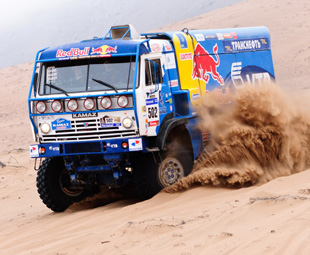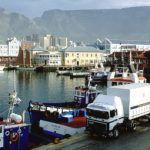The secret is out

The secret of the fuel management technology used in the winning trucks in the Dakar Rally is coming to South Africa. Omnicomm’s intelligent fuel sensors are used in the world-beating Kamaz trucks and the Russian company has now set its sights on South Africa.
“Technology transfer into fellow members of the trading bloc consisting of Brazil, Russia, India, China and South Africa (BRICS) is a key strategic move,” says fuel management expert Yury Panikov, Omnicomm’s export manager. The company currently accounts for 65 percent of the fuel telematics market in Russia.
“Sky high diesel prices mean there is a common objective – the necessity to cut fuel consumption.” Panikov sees intelligent GPS reporting as the ideal solution for South Africa given the vast distances, climate extremes and problems with fuel fraud.
Panikov explains: “Intelligent sensors in the truck’s fuel tank communicate status and all fuel events back to base by GPS, around the clock, no matter where the vehicle may be. Management no longer has to wait for vehicles to return to the depot, but instead can monitor them on a dynamic real-time basis identifying fuel wastage caused by inefficient driving or sharp practice.”
He adds: “It’s through torture-testing in extreme conditions that we developed the technology for everyday fleet efficiency. The leading-edge technology is tested and proven in motor sport events such as the Dakar Rally where harsh terrain and high temperatures punish the vehicles and the drivers are under constant pressure to perform.”
For maximum performance, it’s vital to prune redundant weight. Fuel management is thus a vital category as every 100 unused litres adds 83 kg to the truck’s mass. Yet it’s also critical not to underestimate fuel requirements.
In the 2005 Dakar Rally, before it was using the new technology, Kamaz took 18th place simply because its team ran out of fuel only 50 km from the finishing line. “Of the many things that can go wrong during a rally such as this, running out of fuel is frustrating as it pales in comparison other hazards,” says Panikov.
“In 2005, the turbulence of ride conditions, especially over soft quicksand and stony surfaces, ate into fuel consumption and confused conventional gauges, resulting in inaccurate fuel calculations,” he adds. Learning the lesson, Kamaz co-operated with Omnicomm to create a solution using sensors that measure fuel levels and consumption to over 99 percent accuracy, and are unaffected by vibration. Status is displayed in the cab and sent to base by GPS. In 2013, Kamaz made a clean sweep of the podium.
For off-road applications in South Africa, such as mining and civil engineering, the operational terrain is not dissimilar to rally conditions. Trucks operate round the clock on uneven surfaces and their rocking and rolling confuses conventional fuel gauges. The solutions obtained with Kamaz are directly transferable and have been successfully adapted for mining and construction.
Conditions on the N3 corridor from Durban to Johannesburg may be less hazardous than the dunes and deserts of Peru and Chile, but there are still parallels – even if the scale is different. “Tight deadlines, drivers working long hours and the challenge to measure and manage fuel usage mean the technology used on Kamaz trucks is just as applicable,” Panikov concludes.
Published by
Focus on Transport
focusmagsa




